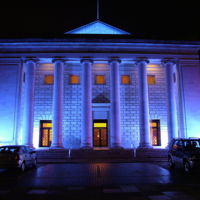Description
Taking place indoors in the Southampton Guildhall in May 1947, the Southampton Quincentenary Pageant was staged as part of a larger celebration put on to acknowledge the anniversary of the granting of a County Town charter 1447.
Historical pageants, a sort of amateur re-enactment, were incredibly popular forms of engagement with the past in the early to mid 20th century. They usually took the form of a series of chronological episodes, often starting as far back as the Romans and sometimes coming right up to the present day. The cast was almost always made up of local volunteers, and could be massive - as many as 10,000 people in some cases. You can read more about historical pageants in Britain on this website.
Southampton's pageant was written by the local historian Elsie Sandell, with help from Tudor House curator Norman Cook. Around 200 members of the Theatre Guild took acting parts. The storyline included: the trial scene of the conspirator’s against Henry V in 1415; the visit of Margaret of Anjoy to God’s House in 1445; the presentation of the Charter of Incorporation of the Borough in 1445, and the charter creating the County of the Town of Southampton in 1447; Henry VII feasting on board a Venetian galley in 1518; and a depiction of a raucous Elizabethan ‘ale house’.
The final proper scene was the departure of the Pilgrim Fathers, including (allegedly local man John Alden, from the West Quay in 1620. The pageant then cut to the present, as American soldiers inspected the Pilgrim Father’s Memorial – with one remembering how he and nearly two million other Americans were Pilgrim descendants. The soldier then read aloud from a guidebook, detailing the history of the port and its relations with the outside world, before the Narrator reminded the audience of the part that Southampton and the American servicemen who had left her port had played in the liberation of Europe in the Second World War. Like in many other important centres of trade and industry, Southampton had suffered disproportionately during the War – and still wore the signs of extensive bomb damage. In dramatic form, the pageant – and the incorporation of the Mayflower and American servicemen in particular – was an attempt to provide a jovial yet proud sense of the heroic role that Southampton had again played in an ‘Anglo-American’ story.
In the epilogue to the pageant, the narrator encouraged ‘citizens of old Southampton’ to ‘build again your town, so that in years to come, prosperity and fame and happiness be yours in this great port upon the southern shores of our dear England’ while also keeping ‘strict watch and ward that all your ancient heritage be saved and in its age-old beauty kept secure, that, in the churches, towers and bulwarks of the past, the future generations still may see the strong foundations of our mighty port Southampton.’

